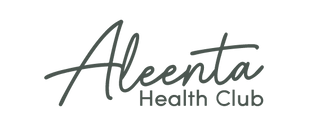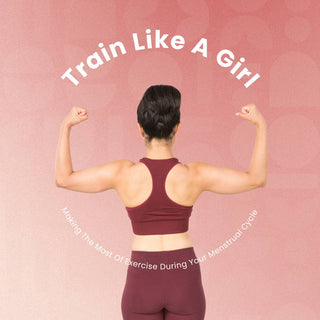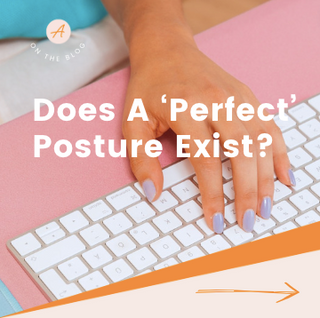We all need this in our lives. Period.
Do you ever find yourself struggling through a workout that you were easily able to conquer a few days earlier? One minute you're sweating, smiling and smashing out your squats, and the next, you can barely find the energy to put on your tights, let alone do some exercise?
You're not imagining things! Whether you want to maximise performance or just exercise with cyclical harmony, it's time to consider the biochemistry behind the cyclical changes in your body – and how to, quite literally, go with the flow (pun definitely intended).
As you read this, please remember the best form of exercise for you at any given time is the one that simply feels right. Listen to your body!
Why change your workouts to go with your flow?
Female physiology is not a weakness, and informing yourself to work with (not against!) your body's seasons gives you the power to make lasting changes to your strength and well being, and can even help you prevent strain and injury.
In 2019 the US Women's Soccer Team planned their world cup training around their players' periods. They worked incredibly hard at the rights times, without forcing or pushing through discomfort, and won the entire tournament. Sounds pretty cool, hey?
We are strong and powerful, and your training goals don't have to suffer because of your period. You might just have to change up your perspective and routine, to get the most out of every workout.
First things first, a little period 101.
Your cycle is more than just your period.
Science shows just how closely linked your energy levels and the effectiveness of your workouts are to each phase of your cycle – not just during menstruation. In this blog, we characterise your body's cyclical phases as both lunar, and seasonal.
Monthly Cycle.- Menstruation (your period: New Moon, Winter)
- Follicular (pre-ovulation: Waxing Moon, Spring)
- Ovulation (Full Moon, Summer), &
- Luteal (pre-menstruation: Waning Moon, Autumn)
Oestrogen.
Female bodies create two main sex hormones, oestrogen and progesterone. Oestrogen helps regulate your cycle and is responsible for female physical features (breasts, pubic hair etc.) and reproduction. It is also a key driver in the changes that take us from being a girl to a woman. Fluctuations in oestrogen levels affect your brain and mood and often contribute to PMS before your period and hot flushes during menopause.
Progesterone.
The other essential sex hormone produced in the second half of your cycle plays a key role in sexual desire. Progesterone prepares your body for potential pregnancy after ovulation by prohibiting muscle contractions in the uterus that would otherwise cause the body to reject an egg. When you are pregnant, the body continues to produce progesterone to prevent the contractions and stop further ovulation.
Other factors.
Finally, it’s important to note that several things can and will impact your natural cycle. These include hormonal contraception (the pill), IUD’s, eating disorders, stress levels, PCOS and endometriosis (to name a few). If you experience these, it is worth doing further research and chatting to a medical professional about your individual needs.
How to exercise during the different stages of your cycle
Just like you crave different foods and activities throughout the seasons, your body craves different movement patterns throughout your cycle.
Training Phase 1: Winter ❄️
Menstruation
Lasts for: 1 - 7 days depending on your cycle
- Oestrogen and progesterone levels are at their lowest before slowly increasing as your period progresses (the shedding of the endometrial tissue that builds up to line your uterus each month).
- Higher levels of testosterone.
- The body is using glycogen (aka stored fuel) as energy.
- Inflammation, cramping and increased levels of tiredness.
- Bloated
- Tired
- Irritable
- Craving carbs or sweets
Best way to exercise during menstruation: When you're on your period, the best form of exercise is the exercise that you feel like doing. Researchers are in two frames of mind about how to best exercise on your period – we present both options below!
#1 The period ninja:
If you do have the energy, take this opportunity to smash out a turbo-charged workout. Lower oestrogen levels mean you are less prone to injury, and your body is burning fuel more efficiently. Endorphins are also a natural painkiller, and studies have shown that 10 minutes of exercise can help ease lower back pain, increase circulation, reduce cramps and improve your mood. Those increased testosterone levels might also take you to incredible hulk levels of strength. If this is the case, try some low-volume weight training or other power-based activities.
#2 Rest and rejuvenate:
If you don't have this energy, then it is 100% okay to chill out. Take this time to rest and reconnect with yourself, prepping for the next stages of your cycle. Dr Brandon Marcello, PhD, said that "during this time, many women experience an increase in the rate of perceived exertion, so exercises that are moderately difficult feel much more difficult while on your period". If this sounds more like you, consider taking a gentle walk in nature (or to the corner store for more snacks), trying some restorative yin yoga, going for a swim, or enjoying some breath work.
Tip: When exercising on your period, choose activewear that you feel confident and comfortable in. It's also worthwhile using workout-friendly products, like a period cup or period undies. That way, you'll spend more time enjoying the workout and less time worrying about potential leaks.
Training Phase 2: Spring 🌻
Follicular phase
Lunar Cycle: Waxing Moon 🌓
What's happening in your body.
- This stage actually begins on the first day of your period and continues until the of ovulation, but it is easiest to think of it as the time between finishing your period and your ovaries releasing the egg.
- Hormones begin to rise, with oestrogen levels spiking and giving you more energy.
- Your body releases a follicle-stimulating hormone that signals the ovaries to start getting an egg ready for release.
How you may feel.
- Energetic
- Renewed
- Awake
Best way to exercise during the follicular phase:
Just like animals that emerge from their winter hibernation into spring, your body will feel more energised and awake as you leave menstruation and hit your follicular phase. Higher levels of energy and rising hormone levels mean this is the perfect time to try a brand new exercise or get into your favourite cardio - think barre, HIIT, dancing, running and cycling. Right now, your body prefers to burn fat as the primary fuel source, so if you are looking to lose weight, this is a great time to maximise your efforts.
Now is the time to focus on a bit more endurance-based exercise and enjoy movement that helps build lean muscles. Research completed in 2014 by the Medicine and Science in Sports and Exercise journal has shown that higher oestrogen levels in the follicular phase are linked to more pliable hamstring muscles. What does this mean? Take the time to warm up, cool down, and exercise with a little more caution, especially with your knees, as you may be more vulnerable to injury.
Tip: Let your creativity shine during this stage. Strut your stuff in your funky new activewear, and don't be afraid to try a new form of exercise, whether it be a Bollywood dance class, rock climbing, or even just skipping down the street. Werk it, girl.
Training Phase 3: Summer ☀️
Ovulation
- Your body releases a luteinising hormone to trigger the start of ovulation, aka the release of the egg.
- Oestrogen drops briefly at the beginning, and progesterone increases, before both hormones peak as you enter the luteal phase.
- Sex drive spikes alongside progesterone. In other words, your body is ready for a baby!
How you may feel.
- Vibrant
- Energised
- Sexy
- Magnetic
You know that time in the month when you're really feeling yourself? There's a little spring in your step, maybe you're keen to get a little more frisky with your lover, and you feel like you're walking on cloud nine? Chances are you're ovulating.
Like the follicular phase, you will have plenty of energy to try new workouts and enjoy some higher intensity exercise during ovulation. You're likely to be feeling a little extra social, so make the most of group fitness classes like barre, power pilates and power yoga, as well as HIIT and boxing workouts. This is also the perfect opportunity to put on that new dress of yours and hit the dance floor with your girls.
From the biology side of things, just like the follicular phase, the higher oestrogen levels may increase your chance of injury, so really make an effort to warm up and cool down. Towards the end of ovulation, as you transition into the luteal phase, the spike in your hormones may lead to increased fluid retention. This can reduce your sweat rate and the amount of oxygen delivered to your muscles, making you hotter. While this isn't a huge thing to worry about, make sure you keep up your water intake and watch your body temp.
Tip: The peak in your sex drive is always an excellent excuse for a different kind of cardio with your flame. If you're not looking to have a baby, just make sure you consider your contraception, as you are super fertile right now!
Training Phase: Autumn 🍂
Luteal phase
Lasts for: 10 - 14 days
Lunar Cycle: Waning Moon 🌗
What's happening in your body.
- You'll experience a few hormonal ups and downs as oestrogen and progesterone peak at the end of ovulation and then begin to decrease.
- PMS symptoms will kick in. You know, the fun stuff, like mood swings, irritability, tiredness and cravings.
- Ovulation will increase basal body temperature, and your energy intake tends to be higher, adding another reason for food cravings.
- Peaking oestrogen and progesterone levels suppress gluconeogenesis, which is the process necessary to use energy stores in the body. This means you may need to provide more external carb sources (yay, bread!).
How you may feel:
- Sluggish
- Moody
- Less Motivated
Best way to exercise during the luteal phase:
Think of this phase like a slippery slide into your period; you'll begin at the top with heaps of post-ovulation energy before gradually feeling your energy levels drop while your body prepares for menstruation. We recommend varying your training as this cycle transition occurs.
Moving your body in one way or another is never bad, and exercise will help reduce the fluid retention that may have started at the end of ovulation. It will also release plenty of endorphins to help with PMS-induced mood swings.
Get it, girl
Regardless of whether you are an elite athlete or an everyday gal just trying to get in her daily workout, there is no reason why your period cycle should impact your training goals.
Take the time to get to know your body and your cycle; after all, it is the only body you have. It's time we stopped working against it and instead recognised our menstrual cycle as the superpower that it truly is.
Researched And Written By Abbie Taylor: Content Writer, Barre & Pilates Instructor
References, research and articles.
- https://www.nature.com/articles/0803699
- https://pubmed.ncbi.nlm.nih.gov/25447680/
- https://blog.insidetracker.com/training-around-menstrual-cycle
- https://www.womenshealth.com.au/the-best-type-of-exercise-for-every-stage-of-your-menstrual-cycle
- https://www.healthline.com/health/exercise-during-period
- https://blog.insidetracker.com/training-around-menstrual-cycle
- https://www.healthline.com/health/exercise-during-period
As with anything that you read, we advise applying critical thinking and doing further research from multiple reputable sources. Studies on women's exercises physiology is still considered fairly new (the majority of studies have been on men and only within the last 40 years has there been an increasing focus on women and the impact of our hormones on exercise) with new evidence and data constantly emerging. Our blog is a great starting point and overview to provide you with easy to understand information, this is our opinion and thoughts based on the research and resources that we have found.




